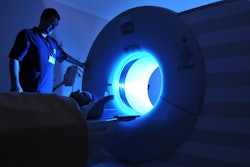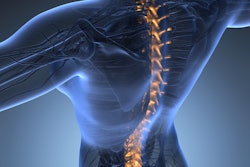An automated protocol for thoracic vertebrae of cancellous bone segmentation and radiomics bone mineral density (BMD) assessment shows promise for opportunistic BMD screening on chest low-dose CT (LDCT), researchers have found.
The findings could improve patient care, according to a team led by Shigeng Wang of First Affiliated Hospital of Dalian Medical University in Dalian, Liaoning, China. The study results were published September 19 in Academic Radiology.
"BMD measurement is a critical index for the diagnosis of osteoporosis, risk evaluation of fractures, and treatment effectiveness assessment," the authors noted.
Osteoporosis is a chronic bone disease that increases an individual's risk of fractures and is often underdiagnosed. Dual-energy x-ray absorptiometry (DEXA) has long been the gold standard for assessing the condition, but it can be hindered by overlapping anatomy, vascular calcification, and degenerative spine changes.
That's why LDCT is sparking interest in this indication. The modality is used for lung cancer screening, and it's possible that information it gleans could be used opportunistically to evaluate patients' bone mineral density -- especially with a boost from AI in the form of automatic segmentation of vertebrae, Wang and colleagues explained.
To explore this possibility, the team developed a model for osteoporosis screening based on LDCT images that incorporated an automatic deep-learning thoracic vertebrae of cancellous bone segmentation model and radiomics analysis. The group conducted a study that included 442 individuals who underwent both LDCT and quantitative CT exams; participants were randomly categorized into training, internal testing, and external testing cohorts.
Wang and colleagues trained the thoracic vertebrae of cancellous bone segmentation model using VB-Net -- evaluating its performance using the Dice coefficient -- and built predictive models for assessing bone mineral density using radiomics based on automatic segmentation and manual segmentation. They gauged the performance of the radiomics models using the area under the operating curve (AUC) measure and specificity and sensitivity percentages.
The investigators found Dice coefficients for the thoracic vertebrae of cancellous bone segmentation model was 0.99 for the internal testing cohort and 0.94 for the external cohort (with 1 as reference).
As for the radiomics models, the researchers found the following:
| Performance results of radiomics models for assessing bone mineral density on LDCT | ||
|---|---|---|
| Measure | Manual segmentation radiomics model | Automatic segmentation radiomics model |
| Training set | ||
| AUC | 0.95 | 0.96 |
| Accuracy | 92% | 88% |
| Sensitivity | 94% | 93% |
| Specificity | 90% | 85% |
| Internal testing set | ||
| AUC | 0.94 | 0.98 |
| Accuracy | 91% | 93% |
| Sensitivity | 97% | 98% |
| Specificity | 84% | 86% |
| External testing set | ||
| AUC | 0.95 | 0.96 |
| Accuracy | 89% | 90% |
| Sensitivity | 94% | 92% |
| Specificity | 83% | 87% |
These results could translate to better osteoporosis evaluation, according to the authors.
"The radiomics features extracted from thoracic vertebrae of cancellous bone of LDCT images offer information for the assessment of BMD and may serve as a valuable tool for opportunistic osteoporosis screening with high cost-effectiveness," they concluded.
The complete study can be found here.




















